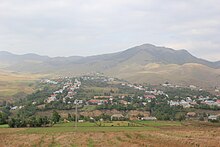Doukhobors
They rejected the secular government, the Russian Orthodox priests, icons, all church rituals, and the belief the Bible is a supreme source of divine revelation.
Their modern name, first in the form Doukhobortsy (Russian: духоборцы, dukhobortsy ("Spirit wrestlers") ) is thought to have been first used in 1785 or 1786 by Ambrosius the Archbishop of Yekaterinoslav[13][15] or his predecessor Nikifor (Nikephoros Theotokis).
[13][18] The first known use of the spelling Doukhobor is in a 1799 government edict exiling 90 of the group to Finland;[13] presumably the Vyborg area, which was part of the Russian Empire at the time, for producing anti-war propaganda.
[20] In 1802, Tsar Alexander I encouraged the resettlement of religious minorities to the "Milky Waters" (Molochnye Vody) region around the Molochnaya River around Melitopol in modern-day southern Ukraine.
[19] When Nicholas I succeeded Alexander as Tsar, on February 6, 1826, he issued a decree intending to force the assimilation of the Doukhobors through military conscription, prohibiting their meetings, and encouraging conversions to the established church.
[13][18] On October 20, 1830, another decree followed, specifying all able-bodied members of dissenting religious groups engaged in propaganda against the established church should be conscripted and sent to the Russian army in the Caucasus while those not capable of military service, and their women and children, should be resettled in Russia's recently acquired Transcaucasian provinces.
Under instructions from Verigin, the Large Party stopped using tobacco and alcohol, divided their property equally among the members of the community, and resolved to adhere to the practice of pacifism and non-violence.
As the Doukhobors gathered to burn their guns on the night of June 28/29 (July 10/11, Gregorian calendar) 1895, while singing psalms and spiritual songs, government Cossacks arrested and beat them.
However, the Cyprus experiment soon proved to be disastrous: beset by disease (made worse by insufficient food that met the Doukhobors' religious requirements) as well as internal disagreements over community organization, nearly ten percent of the colony died by early 1899.
The modern descendants of the first wave of Doukhobor emigrants continue to live in southeastern British Columbia communities such as Krestova, and in southern Alberta and Saskatchewan.
Their communal lifestyle seemed suspicious, their refusal to send children to school was considered deeply troubling, while pacifism caused anger during the First World War.
Tumultuous political posturing and years of polarized social disagreements eventually brought some Doukhobours to the point of protests aimed at maintaining their simple, non-materialistic, and autonomous communal living.
The "oath" issue resulted in a three-way split of the Doukhobor immigrants in Canada:[13][16] Of these groupings, the Independents integrated the most readily into Canadian capitalist society.
While the radical Sons of Freedom sect gained notoriety for their extreme protests, including arson and public disobedience, they represented only a small faction of the Doukhobor population.
The Sons of Freedom emerged in the early 20th century as a reaction to increasing government pressure on Doukhobors to send their children to public schools, pay taxes on their land, and integrate into society.
Unlike other religious groups, such as the Amish and Hutterites, Doukhobors were never granted exemptions from these requirements, which fueled resentment and radicalized a small faction of the community.
Unlike traditional residential schools operated by religious organizations, New Denver was run directly by the provincial government and functioned more as a detention center than an educational institution.
The living conditions were bleak, with strict regimentation, inadequate medical care, and emotional isolation from their families, who were forbidden from visiting or contacting them regularly.
Many survivors of the New Denver residential school have reported lifelong struggles with identity loss, emotional trauma, substance abuse, and difficulty reintegrating into their communities.
Additionally, the historical context of violence against the Doukhobors, including state-sanctioned repression, has left deep psychological scars, fostering a legacy of trauma that affects interpersonal relationships and community cohesion.
As a result, the interplay of economic hardship and the lingering effects of violence continues to challenge the Doukhobor community, complicating efforts toward recovery and cultural revitalization.
Studies have shown that individuals who experienced childhood maltreatment, a group that includes many descendants of residential school survivors, are more likely to face adverse outcomes in adulthood.
A study focusing on the Interior region of British Columbia highlighted that individuals who died from drug toxicity often had histories of unemployment, experiences of violence or abuse, and early substance use—factors that are prevalent in communities grappling with intergenerational trauma.
A study focusing on the Interior region of British Columbia highlighted that individuals who died from drug toxicity often had histories of unemployment, experiences of violence or abuse, and early substance use—factors that are prevalent in communities grappling with intergenerational trauma.
[48][49][50][51][52][53][54][55] During 1947 and 1948, Sullivan's Royal Commission investigated acts of arson and bombing attacks in British Columbia and recommended several measures intended to integrate the Doukhobors into Canadian society, notably through the education of their children in public schools.
Few protested against military service; of 837 Russian court-martial cases against conscientious objectors recorded between the beginning of World War I and April 1, 1917, 16 had Doukhobor defendants, none of whom hailed from the Transcaucasian provinces.
[26] Doukhobor oral holy hymns, which they call the "Book of Life" (Russian: Zhivotnaya kniga), de facto replaced the written Bible.
[81] The Doukhobors took with them to Canada a Southern Russian dialect, which in the following decades changed under the influence of Canadian English and the speech of the Ukrainian settlers in Saskatchewan.
[19][82] Over the next 10 or 20 years, the Doukhobors and others, mostly speaking a variety of Southern Russian dialects, arrived at the Molochna from several provinces, most of which are located in modern-day eastern Ukraine and south-central Russia.
Remarkable was the dropping of the final -t in the third-person singular form of verbs, which can be considered a Ukrainian feature and is also attested in some Russian dialects spoken in Southern Ukraine (e.g., Nikolaev near the Doukhobors' former homeland on the Molochna).







